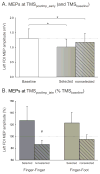Dissociating the influence of response selection and task anticipation on corticospinal suppression during response preparation
- PMID: 25128431
- PMCID: PMC4259874
- DOI: 10.1016/j.neuropsychologia.2014.08.006
Dissociating the influence of response selection and task anticipation on corticospinal suppression during response preparation
Abstract
Motor behavior requires selecting between potential actions. The role of inhibition in response selection has frequently been examined in tasks in which participants are engaged in some advance preparation prior to the presentation of an imperative signal. Under such conditions, inhibition could be related to processes associated with response selection, or to more general inhibitory processes that are engaged in high states of anticipation. In Experiment 1, we manipulated the degree of anticipatory preparation. Participants performed a choice reaction time task that required choosing between a movement of the left or right index finger, and used transcranial magnetic stimulation (TMS) to elicit motor evoked potentials (MEPs) in the left hand agonist. In high anticipation blocks, a non-informative cue (e.g., fixation marker) preceded the imperative; in low anticipation blocks, there was no cue and participants were required to divide their attention between two tasks to further reduce anticipation. MEPs were substantially reduced before the imperative signal in high anticipation blocks. In contrast, in low anticipation blocks, MEPs remained unchanged before the imperative signal but showed a marked suppression right after the onset of the imperative. This effect occurred regardless of whether the imperative had signalled a left or right hand response. After this initial inhibition, left MEPs increased when the left hand was selected and remained suppressed when the right hand was selected. We obtained similar results in Experiment 2 except that the persistent left MEP suppression when the left hand was not selected was attenuated when the alternative response involved a non-homologous effector (right foot). These results indicate that, even in the absence of an anticipatory period, inhibitory mechanisms are engaged during response selection, possibly to prevent the occurrence of premature and inappropriate responses during a competitive selection process.
Keywords: Action selection; Competition resolution; Impulse control; Inhibition; Motor preparation; Movement; Transcranial magnetic stimulation.
Copyright © 2014 Elsevier Ltd. All rights reserved.
Figures





Similar articles
-
Influence of Delay Period Duration on Inhibitory Processes for Response Preparation.Cereb Cortex. 2016 Jun;26(6):2461-70. doi: 10.1093/cercor/bhv069. Epub 2015 Apr 16. Cereb Cortex. 2016. PMID: 25882038 Free PMC article.
-
Preparatory inhibition: Impact of choice in reaction time tasks.Neuropsychologia. 2019 Jun;129:212-222. doi: 10.1016/j.neuropsychologia.2019.04.016. Epub 2019 Apr 20. Neuropsychologia. 2019. PMID: 31015024
-
Comparison of the two cerebral hemispheres in inhibitory processes operative during movement preparation.Neuroimage. 2016 Jan 15;125:220-232. doi: 10.1016/j.neuroimage.2015.10.007. Epub 2015 Oct 14. Neuroimage. 2016. PMID: 26458519 Free PMC article.
-
Transcranial Magnetic Stimulation: Decomposing the Processes Underlying Action Preparation.Neuroscientist. 2016 Aug;22(4):392-405. doi: 10.1177/1073858415592594. Epub 2015 Jul 10. Neuroscientist. 2016. PMID: 26163320 Review.
-
A selectionist account of de novo action learning.Curr Opin Neurobiol. 2011 Aug;21(4):579-86. doi: 10.1016/j.conb.2011.05.004. Epub 2011 Jun 9. Curr Opin Neurobiol. 2011. PMID: 21641793 Review.
Cited by
-
Motor Preparation for Action Inhibition: A Review of Single Pulse TMS Studies Using the Go/NoGo Paradigm.Front Psychol. 2019 Feb 21;10:340. doi: 10.3389/fpsyg.2019.00340. eCollection 2019. Front Psychol. 2019. PMID: 30846954 Free PMC article. Review.
-
Planning face, hand, and leg movements: anatomical constraints on preparatory inhibition.J Neurophysiol. 2019 May 1;121(5):1609-1620. doi: 10.1152/jn.00711.2018. Epub 2019 Feb 20. J Neurophysiol. 2019. PMID: 30785815 Free PMC article.
-
Using a Double-Coil TMS Protocol to Assess Preparatory Inhibition Bilaterally.Front Neurosci. 2018 Mar 8;12:139. doi: 10.3389/fnins.2018.00139. eCollection 2018. Front Neurosci. 2018. PMID: 29568258 Free PMC article.
-
Physiological Markers of Motor Inhibition during Human Behavior.Trends Neurosci. 2017 Apr;40(4):219-236. doi: 10.1016/j.tins.2017.02.006. Epub 2017 Mar 21. Trends Neurosci. 2017. PMID: 28341235 Free PMC article. Review.
-
Effect of Aging on Motor Inhibition during Action Preparation under Sensory Conflict.Front Aging Neurosci. 2016 Dec 27;8:322. doi: 10.3389/fnagi.2016.00322. eCollection 2016. Front Aging Neurosci. 2016. PMID: 28082896 Free PMC article.
References
-
- Aron AR. The neural basis of inhibition in cognitive control. Neuroscientist. 2007;13:214–228. - PubMed
-
- Brown SD, Heathcote A. The simplest complete model of choice response time: linear ballistic accumulation. Cogn Psychol. 2008;57:153–178. - PubMed
-
- Chen R, Hallett M. The time course of changes in motor cortex excitability associated with voluntary movement. Can J Neurol Sci. 1999;26:163–169. - PubMed
-
- Cisek P. Making decisions through a distributed consensus. Curr Opin Neurobiol. 2012;22:927–936. - PubMed
Publication types
MeSH terms
Grants and funding
LinkOut - more resources
Full Text Sources
Other Literature Sources

